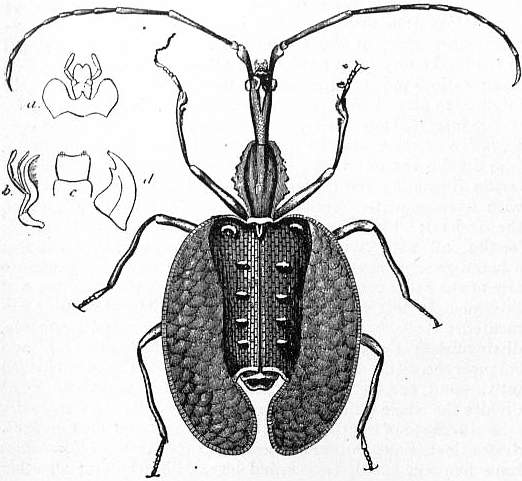Adephaga.—This tribe includes beetles of carnivorous habit with five segments on every foot, simple thread-like feelers with none of the segments enlarged to form club or pectination, and the outer lobs (galea) of the first maxilla usually two-segmented and palpiform (fig. 4 b). The transverse fold of the hind-wing is towards the tip, about two-thirds of the wing-length from the base. At this fold the median nervure stops and is joined by a cross nervure to the radial, which can be distinguished throughout its length from the subcostal. There are four malpighian tubules. In the ovarian tubes of Adephaga small yolk-chambers alternate with the egg-chambers, while in all other beetles there is only a single large yolk-chamber at the narrow end of the tube. The larvae (fig. 2 c) are active, with well-chitinized cuticle, often with elongate tail-feelers (cerci), and with five-segmented legs, the foot-segment carrying two claws.
 |
| Fig. 4.—Mormolyce phyllodes. Java. a, Labium; b, maxilla; c, labrum; d, mandible. |
The generalized arrangement of the wing-nervure and the nature of the larva, which is less unlike the adult than in other beetles, distinguish this tribe as primitive, although the perfect insects are, in the more dominant families, distinctly specialized. Two very small families of aquatic beetles seem to stand at the base of the series, the Amphizoidae, whose larvae are broad and well armoured with short cerci, and the Pelobiidae, which have elongate larvae, tapering to the tail end, where are long paired cerci and a median process, recalling the grub of a Mayfly.
 | |
| Fig. 5.—Pheropsophus Jurinei. W. Africa. | Fig. 6.—Carabus rutilans. Spain. |
The Dyticidae (fig. 2) are Adephaga highly specialized for life in the water, the hind-legs having the segments short, broad and fringed, so as to be well adapted for swimming, and the feet without claws. The metasternum is without the transverse linear impression that is found in most families of Adephaga. The beetles are ovoid in shape, with smooth contours, and the elytra fit over the edges of the abdomen so as to enclose a supply of air, available for use when the insect remains under water. The fore-legs of many male dyticids have the three proximal foot-segments broad and saucer-shaped, and covered with suckers, by means of which they secure a firm hold of their mates. Larval dyticids (fig. 2 b) possess slender, curved, hollow mandibles, which are perforated at the tip and at the base, being thus adapted for sucking the juices of victims. Large dyticid larvae often attack small fishes and tadpoles. They breathe by piercing the surface film with the tail, where a pair of spiracles are situated. The pupal stage is passed in an earthen cell, just beneath the surface of the ground. Nearly 2000 species of Dyticidae are known: they are universally distributed, but are most abundant in cool countries. The Haliplidae form a small aquatic family allied to the Dyticidae.
 | |
| Fig. 7.—Cicindela sylvatica (Wood Tiger-Beetle). Europe. |
Fig. 8.—Manticora tuberculata. S. Africa. |
The Carabidae, or ground-beetles, comprising 13,000 species, form the largest and most typical family of the Adephaga (figs. 4, 5, 6), the legs of all three pairs being alike and adapted for rapid running. In many Carabidae the hind-wings are reduced or absent, and the elytra fused together along the suture. Many of our native species spend the day lurking beneath stones, and sally forth at night in pursuit of their prey, which consists of small insects, earthworms and snails. But a number of the more brightly coloured ground-beetles run actively in the sunshine. The carabid larva is an active well-armoured grub with the legs and cerci variable in length. Great differences in the general form of the body may be observed in the family. For example, the stout, heavy body of Carabus (fig. 6) contrasts markedly with the wonderful flattened abdomen and elytra of Mormolyce (fig. 4), a Malayan genus found beneath fallen trees, a situation for which its compressed shape is admirably adapted. Blind Carabidae form a large proportion of cave-dwelling beetles, and several species of great interest live between tide-marks along the seashore.
 |
| Fig. 9. |
The Cicindelidae, or tiger-beetles (figs. 7, 8) are the most highly organized of all the Adephaga. The inner lobe (lacinia) of the first maxilla terminates in an articulated hook, while in the second maxillae (labium) both inner and outer lobes (“ligula” and “para-glossae”) are much reduced. The face (clypeus) is broad, extending on either side in front of the insertion of the feelers. The beetles are elegant insects with long, slender legs, running quickly, and flying in the sunshine. The pronotum and elytra are often adorned with bright colours or metallic lustre, and marked with stripes or spots. The beetles are fierce in nature and predaceous in habit, their sharp toothed mandibles being well adapted for the capture of small insect-victims. The larvae are more specialized than those of other Adephaga, the head and prothorax being very large and broad, the succeeding segments slender and incompletely chitinized. The fifth abdominal segment has a pair of strong dorsal hook-like processes, by means of which the larva supports itself in the burrow which it excavates in the earth, the great head blocking the entrance with the mandibles ready to seize on any unwary insect that may venture within reach.
Two or three families may be regarded as aberrant Adephaga.
